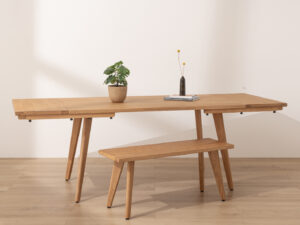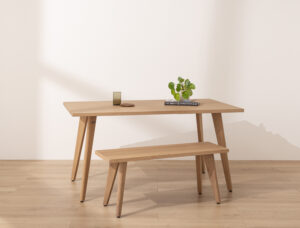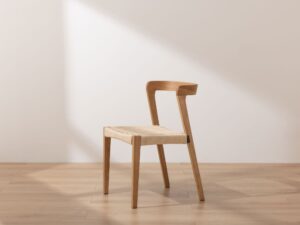Caring For Your Oak Furniture
Oak, a popular type of wood derived from Oak trees, is often used for a wide variety of furniture due to its strength, texture and beautiful grain patterns.
As oak is a dense hardwood, it doesn’t scratch or damage easily meaning oak furniture should last for many years. Nonetheless, oak is still a natural product and needs to be appropriately looked after and cared for to maintain its aesthetics.
Contents
Oak Furniture – General Care
Over time it’s inevitable that your oak furniture may show signs of wear and tear. Fear not! There are numerous ways to keep this to a minimum and guarantee your furniture stays looking beautiful for many years to come. Read our 5 tips below:
- Similar to how our skin, too much sunlight can have an adverse effect on oak making it fade and age rapidly. Consequently, ensure your furniture is kept away from direct sunlight.
- When you’re deciding on the location of your oak furniture, ensure it has adequate ventilation. If it’s near a wall it’s a good idea to keep a gap between the wall and the back of your furniture to let air flow through. This keeps the temperature stable and can help prolong the life of the oak. This also applies if the furniture is being placed near a heat source, such as a fireplace or radiator. Direct heat can cause fibres in the wood to shrink which may result in the wood splitting.
- If you’re placing your furniture on a solid wood floor, be sure to place protective felt under the feet. This will not only protect your floor, but also the base of the foot on your furniture.
- Ensure your oak is regularly waxed (around every 6-9 months). Furniture wax is used to add a protective barrier to the wood, which not only helps to nourish and moisturise the wood but also compliments its natural beauty. Oak is renowned for its durability but can stain or crack easily due to its porous nature, so this step is vital.
- Cleaning oak furniture can be tricky. If the wood is sealed and finished with wax or polish you can usually wipe it down and it will be okay. Once you have wet the wood, you must make sure it has dried properly to avoid it rotting. This is another reason why waxing the furniture is one of the most important parts of the care process.
👉 “Considering A New Dining Table?”
Our stunning dining tables are handmade with love and come in a wide range of styles; from contemporary to rustic and farmhouse styles.
How to wax oak furniture
Waxing your furniture is a simple and easy process but an incredibly important step in maintaining your furniture; particularly for pieces of furniture that may see water, such as a dining table. Waxing not only protects the grain, but it makes the wood crack-resistant which helps keep the finish in the best possible condition.
Here are the steps required for waxing your oak furniture:
- Firstly, make sure you have the right equipment. We recommend using a wax brush or cloth, although avoid using a cloth with lots of fibres. If in doubt, check the instructions from the wax brand you are using.
- Ensure the area is clean from any dust or particles before you start to guarantee the application is smooth.
- It’s always a good idea to test the wax you plan on using on a part of the furniture that’s not in plain sight. This allows you to practice applying the wax and inspecting the quality of the finish inconspicuously.
- When you’re applying the wax, use a circular motion and apply an even pressure. If there are any areas with light scratches or marks, press slightly harder to allow the polish to soak in.
- Make sure you apply the wax in the same direction of the wood grain and in thin coats – this will allow the wax to dry and harden properly.
- Once dry, use a clean cloth buff the wax until it’s shiny.
How to clean oak furniture
As every finish, stain, and type of wood is different, it’s hard to have a one-size-fits-all approach to cleaning wood furniture.
The most effective way of keeping your furniture looking beautiful is to clean it regularly or after every use – simply dampen a soft cloth with water and wipe over, making sure any spills are cleaned up. It’s also important to dust regularly; dust may seem harmless but it can build up over time and may affect the overall finish of the furniture.
If you’re considering using off-the-shelf cleaning products to clean your oak furniture, we’d recommend exercising caution. Many of these products contain harsh chemicals and/or abrasives that will break down the finish of your furniture and could cause irreversible damage. A good rule of thumb is to start with the mildest cleaning solutions first and work your way up from there.
If you want to avoid using harsh chemical cleaning products altogether, you could consider cleaning oak furniture with vinegar as a natural alternative method.
Cleaning oak furniture with vinegar
A mixture of vinegar and water is an alternative, traditional way to clean your oak furniture. It’s also much less risky than cleaning with standard supermarket cleaning products.
- Start by filling a bowl with warm water and add a small amount of white vinegar. The ideal proportions are around 1-3 tablespoons of white vinegar to one cup of warm water. It’s the acidity in the vinegar that makes it ideal for disinfecting.
- When you dip the cloth into the solution, ensure it’s not soaking; we only need it to be damp. Too much liquid on your oak surface is never a good idea, even if only for a short period of time.
- After you have fully wiped the furniture over, rinse the cloth with clean water, wring it to remove excess water and wipe the table again. This will remove the white vinegar residue and any other dirt.
If you don’t have any vinegar to hand you can also use diluted washing up liquid following the same procedure above. Be mindful that this may not be as effective in killing bacteria, but will act as a quick fix before your next shop.
How to remove stains from oak furniture
Removing stains from wood with toothpaste and baking soda
No matter how careful you are, accidents in the home can happen. If you find that your beautiful oak furniture has been stained, there are a number of do-it-yourself remedies to rectify this.
For tough stains, a mixture of toothpaste and baking soda should do the trick.
Most kinds of toothpaste contain mild abrasives which are effective when it comes to removing stains from wood. Simply squirt some toothpaste on a cloth and lightly rub on the affected area; after a few circular scrubs, you should see the mark being lifted. For more stubborn stains, add baking soda to create a mixture that’s slightly more abrasive.
Removing water stains from wood with mayonnaise
Believe it or not, another great way of removing water stains from oak furniture is with mayonnaise. It may seem odd, but the oils in mayonnaise are proven to effectively remove stains by displacing the water. Let it sit for a while, anywhere from an hour to overnight, and simply wipe the mayonnaise away with a dry cloth. It’s a simple technique using a household item but it can save your furniture from those dreaded watermarks.
Removing stains from oak with bleach
You can also remove stains from your oak furniture with another common household item; bleach. You’ll likely feel perturbed putting bleach on to solid wood, but it works! Please note – not all wood reacts well, but bleach is effective at removing stains from oak.
You’ll need to sand the surface of the oak to remove the finish before applying the bleach with a cloth. Allow the bleach to sit on the stain for roughly 10 minutes before wiping away. If the stain persists, you can reapply the bleach and use a stiff brush to scour. To finish, reapply a new layer of stain or clear varnish to protect the wood.
Removing dark stains from oak
Oakwood contains a high amount of tannic acid which can result in dark stains appearing. When the wood is exposed to metal and moisture, such as a wet glass, this triggers a chemical reaction. Whilst these stains are more difficult to remove, it can be achieved.
- Sand the dark stain with 100-grit sandpaper, working with the grain.
- Once you’ve sanded the stain out, apply a coat of varnish to match the original finish.
- To blend with the surrounding wood, feather the edges with super fine steel wool and finish with a quality wood polish. Alternatively, dip a brush in bleach and apply it lightly to the stained area.
- Once the bleach has sat on the stain for a couple of hours and the stain fades back to its original colour, remove with a damp sponge.
- Apply vinegar to the area to prevent further lightening and once dry, finish with stain.
Conclusion
From TV cabinets to wardrobes, dining tables and shelving, oak furniture makes the perfect addition to your home. Many of us have become so accustomed to the throwaway nature of flatpack furniture, we don’t realise the lasting value of furniture made from quality, solid wood. Oak furniture should be considered a quality investment that can last a lifetime when treated right. Rest assured, follow our top tips for looking after your oak furniture, and you’ll have a beautiful piece of furniture for years to come.
For other tips on caring for your home’s wood, read this guide.
If you were looking for a guide on looking after your garden furniture, we’d recommend starting with this guide on how to apply teak oil to garden furniture.
Considering A New Dining Table?
Our stunning dining tables are handmade with love here in the UK and come in a wide range of styles; from contemporary to rustic and farmhouse styles. We're certain you'll find one that looks great in your home.
Just give them a view at the very least 🙂


